Study on Wetland Evolution and Landscape Pattern Changes in the Shaanxi Section of the Loess Plateau in the Past 40 Years
Abstract
:1. Introduction
2. Materials and Methods
2.1. Study Area
2.2. Data Sources and Preprocessing
2.3. Methods
2.3.1. Wetland Dynamic Degree Model
2.3.2. Markov Transfer Matrix
2.3.3. Landscape Pattern Index
2.3.4. Centroid Analysis
3. Results
3.1. Analysis of Spatio-Temporal Variation in Wetland Area
3.1.1. Temporal Variation Analysis
3.1.2. Spatial Variation Analysis
3.2. Analysis of Dynamic Characteristics of Wetland Landscape
3.3. Analysis of Change Characteristics of Wetland Landscape Pattern
3.3.1. Variation Characteristics of Wetland Landscape Pattern at Type Level
3.3.2. Variation Characteristics of Wetland Landscape Pattern at Landscape Level
3.4. Analysis of Centroid Changes of Wetland Landscape Pattern
4. Conclusions
Author Contributions
Funding
Data Availability Statement
Acknowledgments
Conflicts of Interest
References
- Dar, A.S.; Rashid, I.; Bhat, U.S.; Dar, A.J. Evaluation of ecosystem services vis-à-vis perceptions and attitudes of local communities towards Wetland conservation in Kashmir Himalaya. Environ. Dev. 2024, 51, 101041. [Google Scholar] [CrossRef]
- Song, C. Influence of Global Climate Change on wetlands. Wetl. Sci. 2003, 1, 122–127. [Google Scholar]
- Niu, Z.; Zhang, H.; Wang, X.; Yao, W.; Zhou, D.; Zhao, K.; Zhao, H.; Li, N.; Huang, H.; Li, C.; et al. Mapping wetland changes in China between 1978 and 2008. Chin. Sci. Bull. 2012, 57, 2813–2823. [Google Scholar] [CrossRef]
- Hu, S.; Niu, Z.; Chen, Y.; Li, L.; Zhang, H. Global wetlands: Potential distribution, wetland loss, and status. Sci. Total Environ. 2017, 586, 319–327. [Google Scholar] [CrossRef] [PubMed]
- Wang, R.; Wang, Y.; Yang, Q.; Yang, G.; Zhang, G.; Liu, B. The current situation, problems and countermeasures of wetland resources in China. Resour. Sci. 2000, 22, 9–13. [Google Scholar]
- Niu, Z.; Chen, X.; Zhao, K.; Zhou, D.; Guo, J.; Liang, L.; Wang, X.; Li, D.; Huang, H.; Wang, Y.; et al. Remote sensing of wetland change in 1990 and 2000 base year in China. Sci. Sin. (Terrae) 2010, 40, 768–775. [Google Scholar]
- Mao, D.; Wang, Z.; Luo, L.; Ren, C.; Jia, M. Monitoring the Evolution of Wetland Ecosystem Pattern in Northeast China from 1990 to 2013 Based on Remote Sensing. J. Nat. Resour. 2016, 31, 1253–1263. [Google Scholar]
- Jia, M.; Wang, Z.; Mao, D.; Huang, C.; Lu, C. Spatial-temporal changes of China’s mangrove forests over the past 50 years: An analysis towards the Sustainable Development Goals (SDGs). Chin. Sci. Bull. 2021, 66, 3886–3901. [Google Scholar] [CrossRef]
- Copeland, H.E.; Tessman, S.A.; Girvetz, E.H.; Roberts, L.; Enquist, C.; Orabona, A.; Patla, S.; Kiesecker, G. A geospatial assessment on the distribution, condition, and vulnerability of Wyoming’s wetlands. Ecol. Indic. 2010, 10, 869–879. [Google Scholar] [CrossRef]
- Liang, M.; Xie, Z.; Mao, D.; Wang, Z.; Yan, H.; Kang, Y. Landscape Dynamics of Wetlands of International Importance in Dongting Lake Area for 5 Periods since 1980. Wetl. Sci. 2020, 18, 40–46. [Google Scholar]
- Chen, A.; Sui, X.; Wang, D.; Liao, W.; Ge, H.; Tao, J. Landscape and avifauna changes as an indicator of Yellow River Delta Wetland restoration. Ecol. Eng. 2016, 86, 162–173. [Google Scholar] [CrossRef]
- Jiang, W.; Wang, W.; Xie, Z.; Gao, S. A Study on Changes of Wetland Ecology Landscape of Sanjiang Plain Using RS and GIS. Geogr. Geo-Inf. Sci. 2003, 19, 28–31. [Google Scholar]
- Lu, X.; Zhao, Q.; Ye, H.; Li, Y.; Zheng, W.; Li, S.; Li, Y. Analysis of landscape change and driving factors of coastal wetlands in yancheng, Jiangsu Province. Trans. Oceanol. Limnol. 2022, 44, 23–32. [Google Scholar]
- Wang, Y.; Zhao, C.; Zeng, H.; Kang, M.; Zhao, T.; Tang, Y. Spatial-temporal evolution of wetland landscape patterns and its influencing factors in the middle reaches of the Shule River. Arid Zone Res. 2022, 39, 282–291. [Google Scholar]
- Li, H.; Zhang, J.; Guo, J. Spatial-temporal evolution pattern of wetland landscape in the Yellow River Basin. Bull. Surv. Mapp. 2021, 28–33. [Google Scholar] [CrossRef]
- Xu, X.; Wang, X.; Jia, H.; Zhu, X. Seasonal landscape pattern changes in Bayanbulak swan lake alpine wetland. J. Agric. Resour. Environ. 2020, 7, 82–91. [Google Scholar]
- Wang, H.; Xu, Y.; Li, L.; Liu, X.; Jiao, Y. Landscape Pattern Evolution and Driving Force Analysis of Yongnianwa Wetland. Wetl. Sci. 2023, 21, 197–207. [Google Scholar]
- Yin, X.; Tan, C.; Ke, Y.; Zhou, D. Evolution and driving factors of salt marsh wetland landscape pattern in the Yellow River Delta in 1973–2020. Acta Ecol. Sin. 2024, 44, 67–80. [Google Scholar]
- Liu, G.; Bai, Y.; Zhang, T.; Wang, Z.; Hu, C. Effects of wetland reconstruction on bird diversity in the agro-pastoral ecotone of the Loess Plateau. J. Hydraul. Eng. 2018, 49, 1097–1108. [Google Scholar]
- Chen, K.; Cong, P.; Lei, W. Impacts of human activities on the changes of wetland landscape types in the Yellow River Delta during the past 40 years. Mar. Environ. Sci. 2019, 38, 736–744+750. [Google Scholar]
- He, J.; He, L.; Lv, D.; Cheng, Z.; Xue, F.; Liu, B.; Zhang, X. Spatiotemporal variation and its driving mechanism of photosynthetic vegetation in the Loess Plateau from 2001 to 2020. Chin. J. Plant Ecol. 2023, 47, 306–318. [Google Scholar] [CrossRef]
- Yuan, X. Study on the Index System of Wetland Ecological Red Line Delimitation in Guanzhong Area of Shaanxi Province. Master’s Thesis, Baoji University of Arts and Sciences, Baoji, China, 2019. [Google Scholar]
- Ye, Z.; Zhang, H.; Yang, Z.; Zhang, Y.; Li, T.; Zhao, X.; Xue, C. Spatial differentiation effects and risk detection of meteorological elements to vegettation cover on the Loess Plateau of northern Shaanxi. Acta Ecol. Sin. 2024, 44, 2379–2395. [Google Scholar]
- Chen, S.; Zhang, Q.; Chen, Y.; Zhou, H.; Xiang, Y.; Liu, Z.; Hou, Y. Vegetation Change and Eco-Environmental Quality Evaluation in the Loess Plateau of China from 2000 to 2020. Remote Sens. 2023, 15, 424. [Google Scholar] [CrossRef]
- Han, L.; Cao, X.; Zhu, H.; Chen, R.; Zhao, Y.; Liu, Z.; Zhao, Z.; Chang, Y.; Yang, M.; Gao, Y. Change of vegetation coverage and driving factor in the North Shaanxi Loess Plateau based on characteristic zoning. Acta Ecol. Sin. 2023, 43, 8564–8577. [Google Scholar]
- Qiu, H.; Zhang, J.; Han, H.; Cheng, X.; Kang, F. Study on the impact of vegetation change on ecosystem services in the Loess Plateau, China. Ecol. Indic. 2023, 154, 110812. [Google Scholar] [CrossRef]
- State Forestry Bureau. China Wetlands Resources Shaanxi Volume; Chinese Forestry Publishing House: Beijing, China, 2015; pp. 157–158. [Google Scholar]
- Xiong, P.; Zi, S. Types and Distribution Characteristics of Main Wetlands in Shaanxi Province. For. Sci. Technol. Inf. 2020, 52, 14–16+20. [Google Scholar]
- Xu, X.; Liu, J.; Zhang, S.; Li, R.; Yan, C.; Wu, S. China Multi-Period Land Use Land Cover Remote Sensing Monitoring Data Set (CNLUCC); Data Registration and Publishing System of Resource and Environmental Science Data Center, Chinese Academy of Sciences: Beijing, China, 2018. [Google Scholar]
- Liu, J.; Kuang, W.; Zhang, Z.; Xu, X.; Qin, Y.; Ning, J.; Zhou, W.; Zhang, S.; Li, R.; Yan, C.; et al. Basic characteristics and spatial pattern of land use change in China since 1980s. J. Geogr. Sci. 2014, 24, 195–210. [Google Scholar] [CrossRef]
- Chen, Y.; Ke, X.; Liu, F.; Min, M. Area, Distribution and Variation of Wetlands in Wuhan for 4 Periods since 1987. Wetl. Sci. 2019, 17, 553–558. [Google Scholar]
- Gao, J.; Gao, M.; Zhao, Z.; Han, Z.; Han, X.; Gao, W. Wetland Landscape Pattern Changes and Driving Forces in Qilihai Lagoon, 1987–2015. J. Hydroecology 2018, 39, 8–16. [Google Scholar]
- Ren, H.; Ren, C.; Wang, Z.; Liu, P. Dynamics of Area and Distribution of the Wetlands in Changchun City since 1990 and Its Influencing Factors. Wetl. Sci. 2023, 21, 575–581. [Google Scholar]
- Qiu, Z.; Mao, D.; Xiang, H.; Du, B.; Wang, Z. Patterns and Changes of Wetlands in the Yellow River Basin for 5 Periods. Wetl. Sci. 2021, 19, 518–526. [Google Scholar] [CrossRef]
- Ding, P. Analysis of Wetland Landscape Pattern Changes and Driving Forces in Shaanxi Province from 1980 to 2018. Master’s Thesis, Baoji University of Arts and Sciences, Baoji, China, 2021. [Google Scholar]
- Niu, J. Multi-Scale Landscape Pattern Analysis and Ecological Environment Ecaluation of Wetlands in the Yellow River Delta. Master’s Thesis, Shandong Jianzhu University, Jinan, China, 2023. [Google Scholar]
- Wang, S. Dynamic Evolution of Wetland Landscape Pattern in Taihu Lake Basin and Its Multi-Level Driving Mechanism. Master’s Thesis, Suzhou University of Science and Technology, Suzhou, China, 2022. [Google Scholar]
- Lv, J.; Jiang, W.; Wang, W.; Chen, K.; Deng, Y.; Chen, Z.; Li, Z. Wetland landscape pattern change and its driving forces in Beijing-Tianjing-Hebei region in recent 30 years. Acta Ecol. Sin. 2018, 38, 4492–4503. [Google Scholar]
- Liu, X.; Zhang, P.; Zhang, Y.; Liu, X.; Zhao, C. Distribution and Variation of Wetlands in Daqing City for 4 Periods since 1987. Wetl. Sci. 2018, 16, 357–359. [Google Scholar]
- Ding, P.; Liu, B.; Zhang, J.; Yu, B.; Wang, N.; Qi, J.; Wang, Y. Wetland Area, Landscape Index and Its Change in Weinan City in 5 Periods Since 1980. For. Sci. Technol. 2021, 46, 41–45. [Google Scholar]
- Cai, X.; Wu, S.; He, H.; Jiang, C.; Sun, X.; Gao, H.; Zheng, G. Change of Extreme Climate Events in Shaanxi Province under Global Warming. J. Desert Res. 2012, 32, 1095–1101. [Google Scholar]
- Li, M.; Deng, Y.; Ge, C.; Wang, G.; Chai, X. Characteristics of Meteorological Drought across the Loess Plateau and Their Linkages with Large-scale Climatic Factors during 1961–2017. Ecol. Environ. Sci. 2020, 29, 2231–2239. [Google Scholar]
- Lei, X.; Li, Q.; Wang, J.; Li, H.; Li, H.; Li, T. The Drought ang Flood Evolution Law in the Guanzhong Area and the Analyses of the Present Century’s Drought and Flood Characteristics. J. Catastrophology 2016, 31, 101–109. [Google Scholar]
- Ning, X.; Dong, J.; Yan, J. Abrupt change of temperature in northern Shaanxi and its influence on drought and flood disasters. J. Arid Land Resour. Environ. 2011, 25, 102–106. [Google Scholar]
- Xiong, G. Analysis of dynamic evolution characteristics of rainfall and temperature in Guanzhong area. J. Anhui Agric. Sci. 2015, 43, 192–194+198. [Google Scholar]
- Shaanxi Provincial Bureau of Statistics. Shaanxi Statistical Yearbook 2001; China Statistical Publishing House: Beijing, China, 2001. [Google Scholar]
- Shaanxi Provincial Bureau of Statistics. Shaanxi Statistical Yearbook 2011; China Statistical Publishing House: Beijing, China, 2011. [Google Scholar]
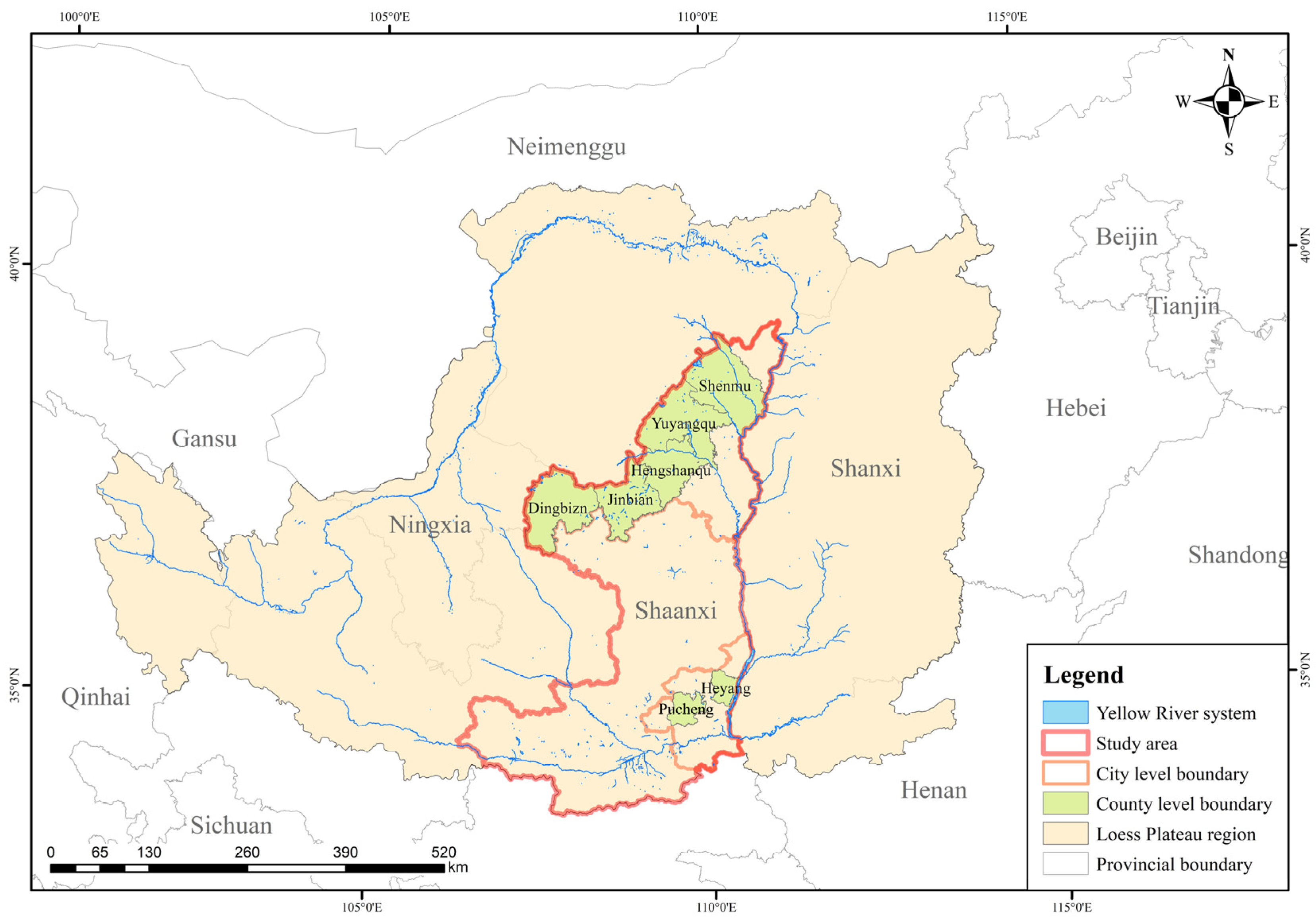
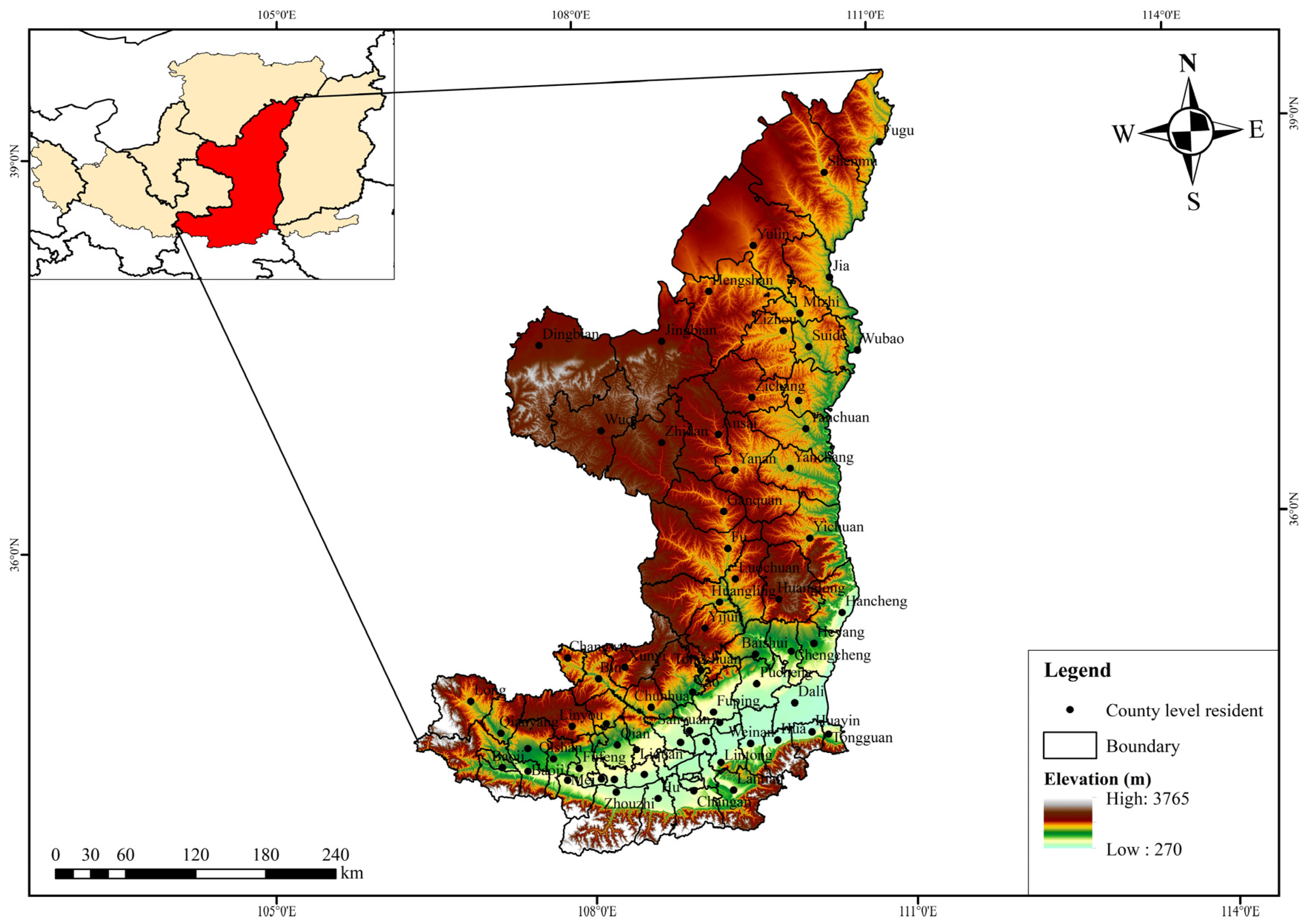
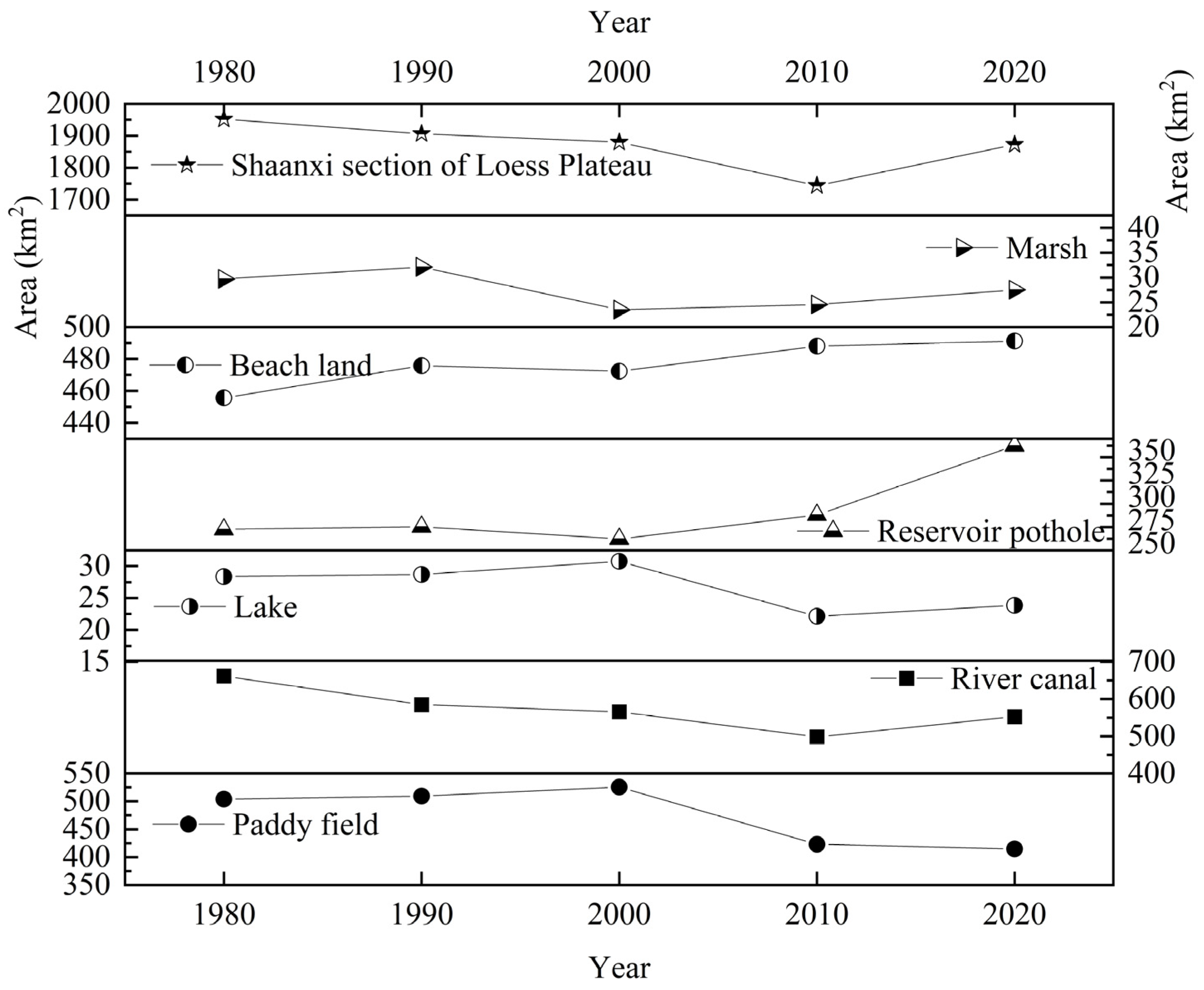
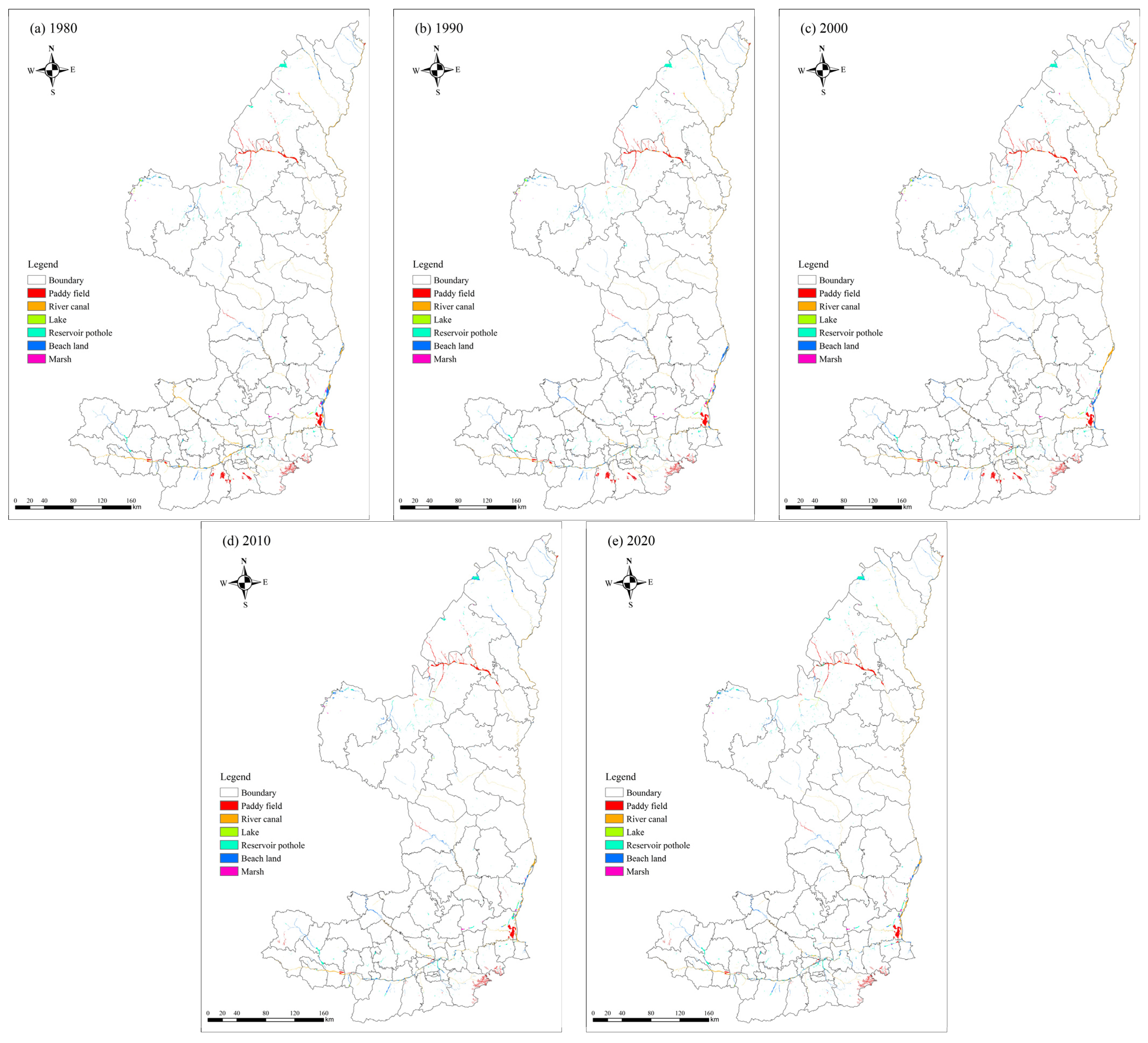
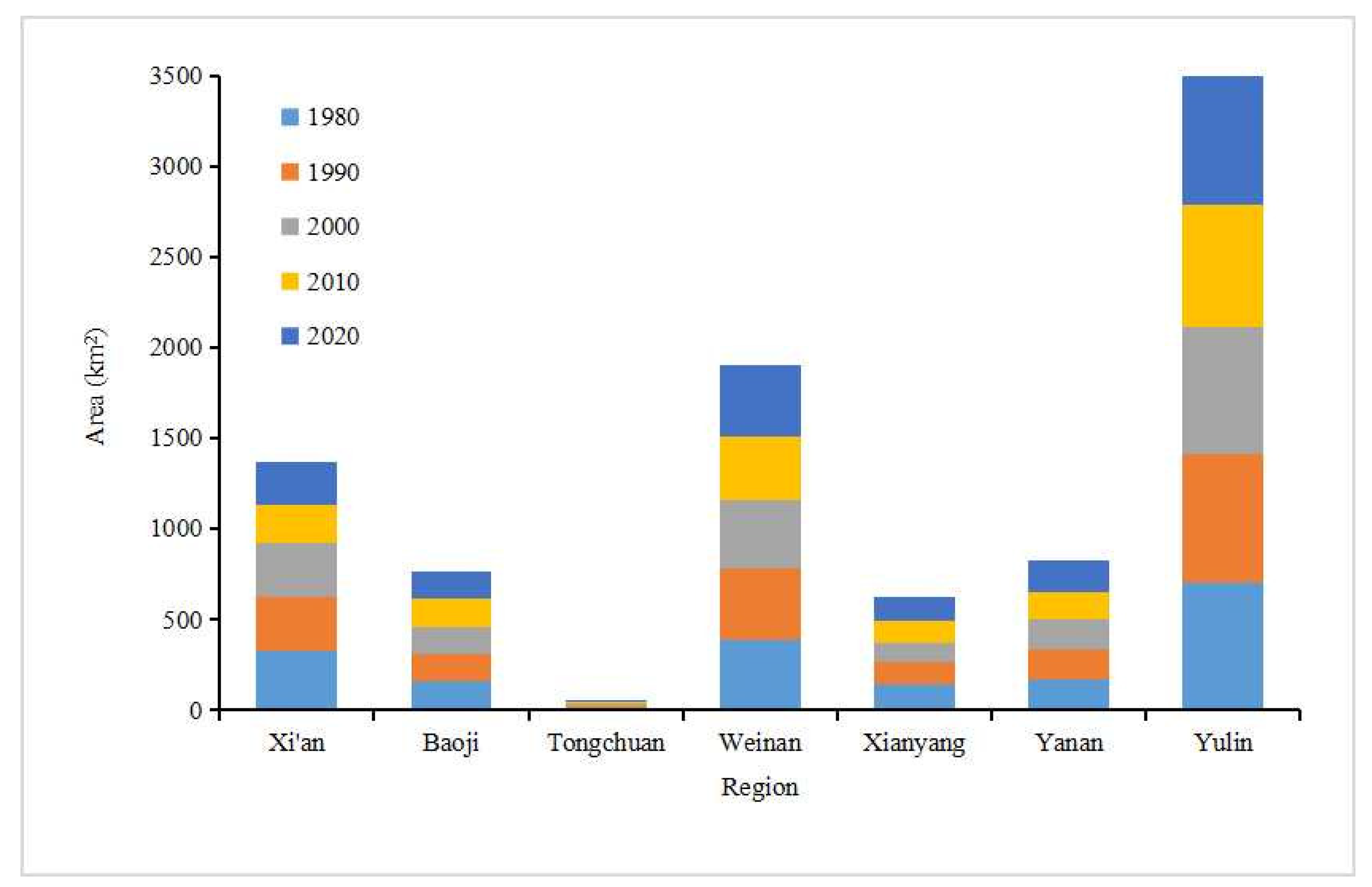



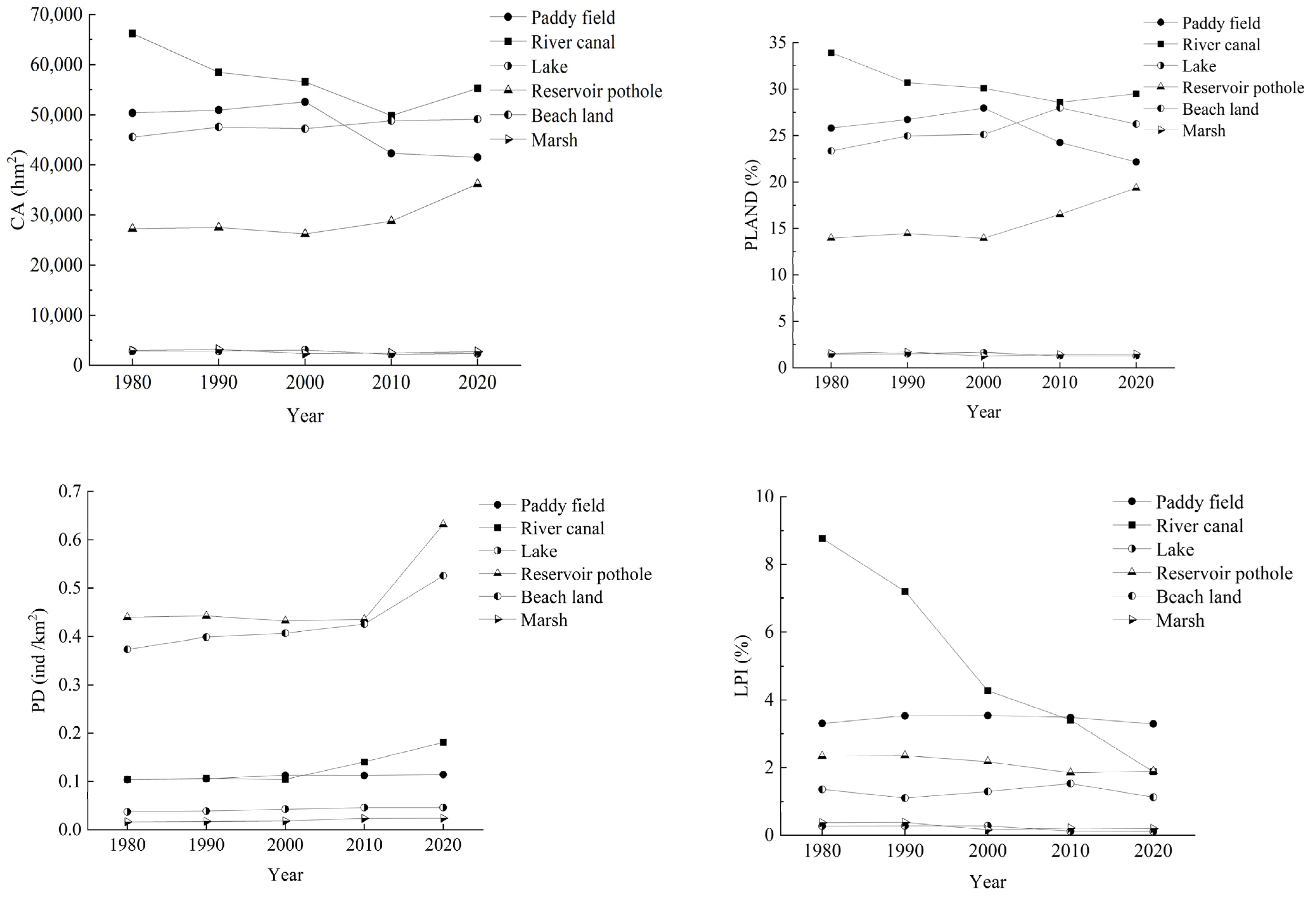


| Wetland Type | Definition |
|---|---|
| Paddy field | It refers to cultivated land with guaranteed water resources and irrigation facilities, where water can be irrigated normally in general years to plant aquatic crops such as rice and lotus root, including cultivated land with the rotation of rice and dry land crops. |
| River canal | It refers to naturally formed and artificially excavated rivers and the land below the perennial water level of the trunk. Artificial canals include embankments. |
| Lake | It refers to land below the perennial water level in the naturally formed water area. |
| Reservoir pothole | It refers to land below the perennial water level in the artificially constructed water storage area. |
| Beach land | It refers to land between the water levels of rivers and lakes in the normal water period. |
| Marsh | It refers to land with flat and low-lying terrain, poor drainage, long-term humidity, seasonal water accumulation or perennial water accumulation and the surface growth of hygrophytes. |
| Landscape Index | Ecological Signification |
|---|---|
| CA | It shows how the landscape component size, especially used to reflect the number of landscapes composed of a certain patch type, affects the richness of species to a certain extent. |
| PD | It is the basic index of landscape pattern analysis, which can not only reflect the number of patches per unit area but also reflect the uniformity of the spatial distribution of landscape patches and can also reflect the degree of landscape fragmentation. |
| NP | This index is used to reflect the heterogeneity of the landscape and can represent the spatial pattern characteristics of the landscape. The value of the index is proportional to the fragmentation of the landscape. Generally speaking, the larger the number of patches, the more serious the fragmentation, and vice versa. |
| LPI | It is one of the key indexes reflecting landscape heterogeneity. To a certain extent, it can help to determine the dominant landscape types in the landscape. A change in its value has a positive correlation with the intensity and frequency of human disturbance, and its change can also reflect the direction and intensity of human activities. |
| LSI | This index measures the shape complexity by calculating the degree of deviation between the shape of a patch in the area and a circle or square of the same area. |
| SHDI | This is a measurement index based on information theory that can reflect the heterogeneity of the landscape and is especially sensitive to the non-uniform distribution of each block type in the landscape. |
| SHEI | This index is equal to the SHDI divided by the maximum possible diversity under a given landscape abundance (equal distribution of each patch type). |
| PLAND | This index is the proportion of the total area of a certain patch type to the total landscape patch area, reflecting the composition of the landscape. To a certain extent, it can reflect the dominant landscape type in the landscape. |
| CLUMPY | It reflects the aggregation and dispersion of patches in the landscape. |
| CONTAG | This index describes the degree of agglomeration or the extension trends of different patch types in the landscape. It is one of the most important indexes to describe the landscape pattern. |
| AREA-MN | It reflects the degree of fragmentation of the landscape. |
| Period | Natural Wetland Area (km2) | Artificial Wetland Area (km2) | Total Wetland Area (km2) |
|---|---|---|---|
| 1980 | 1175.90 | 776.21 | 1952.10 |
| 1990 | 1121.76 | 784.80 | 1906.56 |
| 2000 | 1092.33 | 787.77 | 1880.10 |
| 2010 | 1033.17 | 711.07 | 1744.24 |
| 2020 | 1095.40 | 777.35 | 1872.75 |
| Period | Natural Wetland Area (km2) | Artificial Wetland Area (km2) | ||||||
|---|---|---|---|---|---|---|---|---|
| River Canals | Beach Land | Lakes | Marshes | Total | Paddy Fields | Reservoir Potholes | Total | |
| 1980 | 662.20 | 455.61 | 28.39 | 29.70 | 1175.90 | 503.74 | 272.47 | 776.21 |
| 1990 | 585.12 | 475.80 | 28.72 | 32.12 | 1121.76 | 509.40 | 275.40 | 784.80 |
| 2000 | 565.76 | 472.29 | 30.77 | 23.50 | 1092.33 | 525.59 | 262.19 | 787.77 |
| 2010 | 498.28 | 488.16 | 22.145 | 24.58 | 1033.17 | 423.03 | 288.04 | 711.07 |
| 2020 | 552.70 | 491.30 | 23.86 | 27.54 | 1095.40 | 414.92 | 362.42 | 777.35 |
| Wetland Type | 1980–1990 | 1990–2000 | 2000–2010 | 2010–2020 | 1980–2020 | |||||
|---|---|---|---|---|---|---|---|---|---|---|
| Variation | Rate | Variation | Rate | Variation | Rate | Variation | Rate | Variation | Rate | |
| Paddy fields | 5.66 | 0.11% | 16.19 | 0.32% | −102.56 | −1.95% | −8.10 | −0.19% | −88.81 | −0.44% |
| River canals | −77.08 | −1.16% | −19.36 | −0.33% | −67.49 | −1.19% | 54.42 | 1.09% | −109.51 | −0.41% |
| Lakes | 0.33 | 0.12% | 2.06 | 0.72% | −8.62 | −2.80% | 1.70 | 0.77% | −4.53 | −0.40% |
| Reservoir potholes | 2.93 | 0.11% | −13.22 | −0.48% | 25.85 | 0.99% | 74.38 | 2.58% | 89.95 | 0.83% |
| Beach land | 20.20 | 0.44% | −3.52 | −0.07% | 15.87 | 0.34% | 3.14 | 0.06% | 35.70 | 0.20% |
| Marshes | 2.42 | 0.81% | −8.62 | −2.68% | 1.08 | 0.46% | 2.96 | 1.21% | −2.16 | −0.18% |
| Total wetlands | −45.54 | −0.23% | −26.46 | −0.14% | −135.86 | −0.72% | 128.50 | 0.74% | −79.35 | −0.10% |
| Index | 1980 | 1990 | 2000 | 2010 | 2020 |
|---|---|---|---|---|---|
| NP (ind) | 2098 | 2114 | 2098 | 2063 | 2851 |
| PD (ind/km2) | 1.07 | 1.11 | 1.12 | 1.18 | 1.52 |
| LSI | 106.19 | 107.56 | 107.94 | 110.76 | 117.89 |
| CONTAG (%) | 57.31 | 56.69 | 56.91 | 56.45 | 55.92 |
| SHDI | 1.4559 | 1.473 | 1.4615 | 1.4708 | 1.4806 |
| SHEI | 0.8126 | 0.8221 | 0.8157 | 0.8209 | 0.8263 |
Disclaimer/Publisher’s Note: The statements, opinions and data contained in all publications are solely those of the individual author(s) and contributor(s) and not of MDPI and/or the editor(s). MDPI and/or the editor(s) disclaim responsibility for any injury to people or property resulting from any ideas, methods, instructions or products referred to in the content. |
© 2024 by the authors. Licensee MDPI, Basel, Switzerland. This article is an open access article distributed under the terms and conditions of the Creative Commons Attribution (CC BY) license (https://creativecommons.org/licenses/by/4.0/).
Share and Cite
Xue, Z.; Wang, Y.; Huang, R.; Yao, L. Study on Wetland Evolution and Landscape Pattern Changes in the Shaanxi Section of the Loess Plateau in the Past 40 Years. Land 2024, 13, 1268. https://doi.org/10.3390/land13081268
Xue Z, Wang Y, Huang R, Yao L. Study on Wetland Evolution and Landscape Pattern Changes in the Shaanxi Section of the Loess Plateau in the Past 40 Years. Land. 2024; 13(8):1268. https://doi.org/10.3390/land13081268
Chicago/Turabian StyleXue, Zhaona, Yiyong Wang, Rong Huang, and Linjia Yao. 2024. "Study on Wetland Evolution and Landscape Pattern Changes in the Shaanxi Section of the Loess Plateau in the Past 40 Years" Land 13, no. 8: 1268. https://doi.org/10.3390/land13081268




